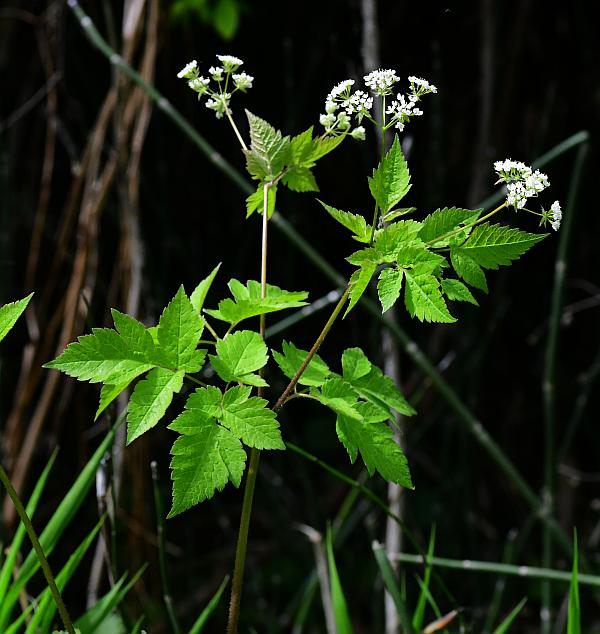Osmorhiza longistylis (Torr.) DC.
Anise Root

Native
CC = 3
CW = 3
MOC = 71
© SRTurner
Osmorhiza longistylis (Torr.) DC.Anise Root | |
 |
Native CC = 3 CW = 3 MOC = 71 |
© SRTurner |
|
Family - Apiaceae Habit - Perennial forb with clusters of tuberous-thickened roots. Plants (especially roots) usually anise-scented. Stems - Ascending to erect, to 1 m tall, glabrous to densely pubescent with spreading hairs, branching.
Leaves - Alternate and often basal, compound, usually petiolate, the uppermost leaves often sessile or nearly so. Sheathing bases not or only slightly inflated. Leaf blades 4-25 cm long, broadly triangular-ovate in outline, ternately or ternately then pinnately 2 or 3 times compound with distinct leaflets, these 3-10 cm long, mostly 1 cm or more wide, ovate to lanceolate or oblong-lanceolate, shallowly to moderately several-lobed and sometimes also with a pair of deep, basal lobes, the margins also toothed, shallowly cordate to long-tapered at the base, narrowed or tapered to a sharp point at the tip, the upper and undersurface sparsely to moderately pubescent with stiff, spreading hairs, especially along the main veins and margins.
Inflorescence - Compound umbels. Umbellets sometimes all or partially of staminate flowers. Involucre of 1-6 bracts, rarely absent, the bracts 3-20 mm long, usually reflexed, linear to lanceolate, with a sharply pointed tip, densely pubescent with stiff, spreading or ascending hairs along the margins and midvein. Rays 3-6, often somewhat unequal in length, usually ascending. Involucel of 4-7 bractlets, these shorter than the flower stalks, similar to the bracts. Flowers 7-19 in each umbellet (usually 7 or fewer perfect, the rest staminate), the stalks 2-5 mm long at flowering, the central flower usually sessile and staminate, those of the perfect flowers elongating to 12 mm at fruiting.
Flowers - Sepals absent. Petals 5, oblanceolate to obovate, rounded or with an abrupt, minute point at the tip, white, subequal but typically one or two larger than the others, to 2 mm long and broad. Stamens 5, alternating with petals, spreading to erect. Styles 2 mm long in flower, longer than petals.
Fruits - Schizocarps 10-22 mm long, linear to narrowly oblong-oblanceolate in outline, long-tapered at the base, tapered to a beak at the tip, flattened laterally, glabrous or pubescent with stiff, ascending bristles along the ribs, greenish brown to dark brown or black with green to dark brown ribs, the mericarps sometimes slightly arched or curved, somewhat narrowed along the commissures, with 5 narrow, angled ribs, these lacking wings.
Flowering - April - June. Habitat - Bottomland and mesic forests, often in ravines, streambanks, shady, moist, disturbed areas. Origin - Native to the U.S. Lookalikes - Osmorhiza claytonii. Other info. - This licorice smelling plant can be found throughout Missouri, as well as much of the northeastern 2/3 of the continental U.S. It ranges into Canada as well. All parts of the plant exhibit a sweet fragrance, which many claim is stronger than that of the closely related O. claytonii. The two plants are virtually identical in appearance, but with a little practice can be reliably distinguished by the length of the styles (see diagram above). Those of C. claytonii are much shorter. Be sure to examine the styles, which are forked in a V-shape, rather than the anther-topped stamens, and be aware that many of the flowers do not have styles. This species is much more common in Missouri than O. claytonii. Photographs taken in the Ozark Scenic Riverways, Shannon County, MO., 5-20-03, and in Columbia, MO., 4-25-04 (DETenaglia); also along the Katy Trail southeast of Dutzow, Warren County, MO, 4-11-2012 and 4-22-2020, and 4-22-2021, Glassberg Conservation Area, Jefferson County, MO, 5-11-2013, and Engelmann Woods Natural Area, Franklin County, MO, 4-28-2025 (SRTurner). |